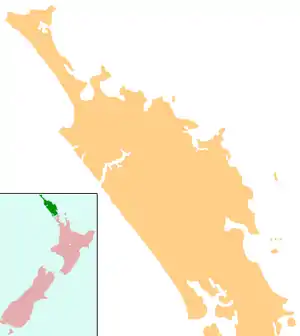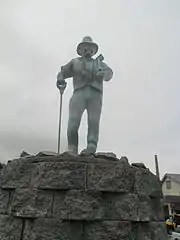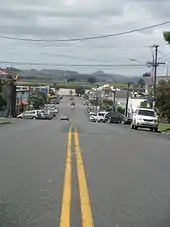Dargaville
Dargaville (Māori: Takiwira) is a town in the North Island of New Zealand. It is situated on the bank of the Northern Wairoa River in the Kaipara District of the Northland region. The town is located 55 kilometres southwest of Whangārei.
Dargaville
Takiwira (Māori) | |
|---|---|
 Victoria Street in Dargaville (2015) | |
| Motto(s): Heart of the Kauri Coast | |
 Dargaville | |
| Coordinates: 35°56′18″S 173°52′18″E | |
| Country | New Zealand |
| Region | Northland Region |
| District | Kaipara District |
| Population (June 2020)[1] | |
| • Total | 4,960 |
| Postcode(s) | 0310 |
It is noted for the high proportion of residents of Croatian descent. The area around it is one of the chief regions in the country for cultivating kumara (sweet potato) and so Dargaville is known by many locals as the Kumara Capital of New Zealand.
History and culture

The town was named after timber merchant and politician Joseph Dargaville (1837–1896).[2] Founded during the 19th-century kauri gum and timber trade, it briefly had New Zealand's largest population.
The area became known for a thriving industry that included gum digging and kauri logging, which was based mainly at Te Kōpuru, several kilometres south of Dargaville on the banks of the Northern Wairoa river. The river was used to transport the huge logs downstream to shipbuilders and as a primary means of transport to Auckland. Dalmatian migrants were particularly prominent in the kauri gum extraction.[3]
Te Houhanga Marae and Rāhiri meeting house is a traditional meeting place for Te Roroa and the Ngāti Whātua hapū of Te Kuihi and Te Roroa.[4][5]
Demographics
| Year | Pop. | ±% p.a. |
|---|---|---|
| 2006 | 4,455 | — |
| 2013 | 4,251 | −0.67% |
| 2018 | 4,794 | +2.43% |
| Source: [6] | ||
Dargaville had a population of 4,794 at the 2018 New Zealand census, an increase of 543 people (12.8%) since the 2013 census, and an increase of 339 people (7.6%) since the 2006 census. There were 1,812 households. There were 2,325 males and 2,469 females, giving a sex ratio of 0.94 males per female. Of the total population, 936 people (19.5%) were aged up to 15 years, 840 (17.5%) were 15 to 29, 1,785 (37.2%) were 30 to 64, and 1,233 (25.7%) were 65 or older. Figures may not add up to the total due to rounding.
Ethnicities were 70.7% European/Pākehā, 35.7% Māori, 7.4% Pacific peoples, 4.4% Asian, and 1.4% other ethnicities. People may identify with more than one ethnicity.
The percentage of people born overseas was 13.3, compared with 27.1% nationally.
Although some people objected to giving their religion, 41.1% had no religion, 43.9% were Christian, and 6.3% had other religions.
Of those at least 15 years old, 282 (7.3%) people had a bachelor or higher degree, and 1,161 (30.1%) people had no formal qualifications. The median income was $22,200. The employment status of those at least 15 was that 1,440 (37.3%) people were employed full-time, 549 (14.2%) were part-time, and 171 (4.4%) were unemployed.[6]
Geography

The nearby Ripiro Beach has the longest unbroken stretches of sand beach in New Zealand, and is largely drivable from one end to the other. This beach is home of the famous local shellfish delicacy called the toheroa. Overexploitation in the 1950s and 1960s caused the population of the shellfish to decline enough that public gathering of the shellfish is now prohibited.[7]
Dargaville is also the gateway to the Waipoua Forest, a protected national park and home of the biggest specimens of Kauri tree in New Zealand, Tāne Mahuta (Māori, meaning "Lord of the Forest") being chief amongst them.
Dargaville is situated by the Wairoa River, with boat moorings adjacent to the town centre. The river is tidal when it passes through Dargaville.
Climate
Köppen-Geiger climate classification system classifies its climate as oceanic (Cfb) with warm summers and mild winters.[8]
| Climate data for Dargaville | |||||||||||||
|---|---|---|---|---|---|---|---|---|---|---|---|---|---|
| Month | Jan | Feb | Mar | Apr | May | Jun | Jul | Aug | Sep | Oct | Nov | Dec | Year |
| Average high °C (°F) | 23.6 (74.5) |
24 (75) |
23 (73) |
20.5 (68.9) |
17.8 (64.0) |
15.8 (60.4) |
15 (59) |
15.4 (59.7) |
16.3 (61.3) |
17.8 (64.0) |
19.7 (67.5) |
21.9 (71.4) |
19.23 (66.61) |
| Daily mean °C (°F) | 18.8 (65.8) |
19.1 (66.4) |
18.3 (64.9) |
16 (61) |
13.5 (56.3) |
11.8 (53.2) |
10.9 (51.6) |
11.4 (52.5) |
12.5 (54.5) |
13.9 (57.0) |
15.5 (59.9) |
17.3 (63.1) |
14.92 (58.86) |
| Average low °C (°F) | 13.9 (57.0) |
14.3 (57.7) |
13.6 (56.5) |
11.5 (52.7) |
9.2 (48.6) |
7.8 (46.0) |
6.8 (44.2) |
7.4 (45.3) |
8.7 (47.7) |
10 (50) |
11.2 (52.2) |
12.7 (54.9) |
10.59 (51.06) |
| Average precipitation mm (inches) | 73 (2.9) |
74.6 (2.94) |
88.5 (3.48) |
89.3 (3.52) |
114.7 (4.52) |
145.2 (5.72) |
126.8 (4.99) |
128.7 (5.07) |
102.3 (4.03) |
91.2 (3.59) |
81.8 (3.22) |
72.3 (2.85) |
1,188.4 (46.83) |
| Source 1: Climate Charts (altitude: 15m)[9] | |||||||||||||
| Source 2: Climate-Data.org (altitude: 22m)[8] | |||||||||||||
Transport

Dargaville is on the junction of State Highways 12 and 14.
North of the town, the Donnellys Crossing Section railway was established to provide access to other logging activities. The first portion of this line was opened in 1889, it reached its greatest extent in 1923, and after operating isolated from the national rail network for decades, it was connected with the North Auckland Line by the Dargaville Branch in 1940. The Donnelly's Crossing Section closed in 1959, but the Dargaville Branch remains in use by a tourist venture, having been closed by KiwiRail since October 2014.[10]
The area around Dargaville is now predominantly a farming region and supports extensive dairy, beef, and sheep farms, as well as a thriving plantation forest industry.
Other attractions are the Kai Iwi lakes some 25 kilometres north of the town, and Pouto Peninsula. Baylys Beach is the local beach, just 13 kilometres from the township, and offers over 90 kilometres of rugged west coast surf.
Education
Dargaville High School is a secondary (years 9-13) school with a roll of 432 students.[11] The school opened in 1921, but was destroyed by fire in 1937 and rebuilt the following year.[12] Dargaville Intermediate is an intermediate (years 7-8) school with a roll of 145 students.[13]
Dargaville Primary School and Selwyn Park School are contributing primary (years 1-6) schools with rolls of 349 students[14] and 110 students[15] respectively. Dargaville Primary was established by 1877. In 1879, it had a roll of 16, which grew to 155 in 1899.[16] Selwyn Park celebrates its 50th Jubilee in 2008.[17]
St Joseph's School is a full primary (years 1-8) school with a roll of 88 students.[18] It is a state integrated Catholic school.[19]
All these schools are coeducational. Rolls are as of March 2020.[20]
Notable people
- Amelia Batistich, writer, was born here in 1905[22]
- Joey Carbery, Irish international rugby union player
- Robert Hornblow (1861–1937), the town's mayor from 1919 to 1925[23]
- Dion Nash, New Zealand cricketer, attended Dargaville High School
- Mike Perjanik, musician, record producer and composer
- Winston Peters, New Zealand politician and leader of the New Zealand First party, attended Dargaville High School
- Lana Searle, New Zealand radio & television host, attended Dargaville High School[24]
- Mark Taylor, All Black
- Frank Watkins, World War II RNZAF pilot
- Mark Williams, singer and recording artist
- Brian Froggatt, New Zealand Paralympian athlete and powerlifter[25]
- Richard Hammond, musician, bass player.[26]
See also
Notes
- "Population estimate tables - NZ.Stat". Statistics New Zealand. Retrieved 22 October 2020.
- Discover New Zealand:A Wises Guide (9th ed.). 1994. p. 15.
- "Dalmatians making their mark 150 years on". Stuff (Dargaville News). 31 January 2009. Retrieved 11 September 2019.
- "Te Kāhui Māngai directory". tkm.govt.nz. Te Puni Kōkiri.
- "Māori Maps". maorimaps.com. Te Potiki National Trust.
- "Statistical area 1 dataset for 2018 Census". Statistics New Zealand. March 2020. Dargaville (109300). 2018 Census place summary: Dargaville
- Carbery, Sara. "Te Kaitiaki Toheroa". Retrieved 1 August 2018.
- "Climate: Dargaville - Climate graph, Temperature graph, Climate table". Climate-Data.org. Retrieved 2014-01-23.
- "Dargaville, New Zealand: Climate, Global Warming, and Daylight Charts and Data". Climate Charts. Archived from the original on 2013-09-19. Retrieved 2014-01-23.
- Annette Lamby (2 November 2015). "Rail cart venture ready to roll in Dargaville". Stuff. Retrieved 21 March 2019.
- Education Counts: Dargaville High School
- Ryburn, Wayne (1999). Tall Spars, Steamers & Gum. Auckland, N.Z.: Kaipara Publications. p. 165. ISBN 0-473-06176-7.
- Education Counts: Dargaville Intermediate School
- Education Counts: Dargaville Primary School
- Education Counts: Selwyn Park School
- Ryburn, p 222
- "Selwyn Park School, Dargaville 50th Jubilee" (– Scholar search). Education Gazette New Zealand. 86 (8). 21 May 2007.
- Education Counts: St Joseph's School
- "Principal's Message". St Joseph's School. Archived from the original on 2008-10-14.
- "New Zealand Schools Directory". New Zealand Ministry of Education. Retrieved 26 April 2020.
- "Dargaville". NorthTec. Archived from the original on 5 June 2009. Retrieved 4 March 2010.
- Obituary: Amelia Batistich, 2004, Life & Stylem NZ Herald News, Retrieved 30 April 2016
- "Mr R. E. Hornblow". The New Zealand Herald. LXXIV (22866). 22 October 1937. p. 14. Retrieved 7 September 2016.
- "Greek theme a real ball". Dargaville News. 31 January 2009.
- http://www.paralympics.org.nz/About/List-of-Paralympians
- http://www.richard-hammond.com
External links
| Wikimedia Commons has media related to Dargaville. |
| Wikivoyage has a travel guide for Dargaville. |